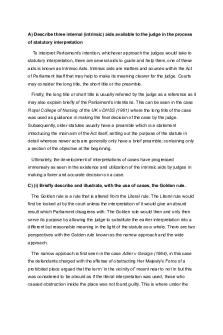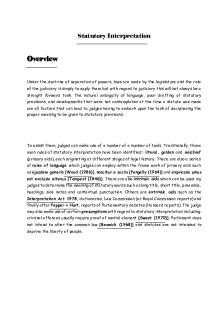Intructions FOR Statutory Interpretation PDF

| Title | Intructions FOR Statutory Interpretation |
|---|---|
| Course | Fundamentals of Australian Law |
| Institution | Western Sydney University |
| Pages | 3 |
| File Size | 111 KB |
| File Type | |
| Total Downloads | 42 |
| Total Views | 139 |
Summary
instructions for statutory interpretation when looking at cases....
Description
BLANK SCAFFOLD FOR STUDENT WORK STEP 1- ESTABLISH JURISDICTION Issue Rule
Did the events occur in the relevant jurisdiction? Common law presumption of interpretation is that legislation does not have extraterritorial effect (Green v Burgess [1960] VR 158). Cite Coco v R (1994) 179 CLR 427 as authority that common law presumptions may be rebutted by the statute itself. Relevant legislation is ##.
Application Conclusion
STEP 2- ESTABLISH THAT LEGISLATION WAS IN FORCE AT THE RELEVANT TIME Issue
Was the legislation in force at the time that ## occurred?
Rule
Legislation presumed not to be retrospective. (Australian Education Union v General Manager of Fair Work Australian (2012) 246 CLR 117). Cite Coco v R (1994) 179 CLR 427 as authority that common law presumptions may be rebutted by the statute itself. Delegated legislation cannot be retrospective: Legislation Act 2003 (Cth), ss 12 and 48; Interpretation Act 1987 (NSW), s 39
Application Conclusion
STEP 3- ESTABLISH THE CENTRAL PRINCIPLE OF INTERPRETATION THAT APPLIES Issue Rule
What is the relevant approach to interpretation of this legislation? Section 15AA Acts Interpretation Act 1901 (Cth) provides that: In interpreting a provision of an Act, the interpretation that would best achieve the purpose or object of the Act (whether or not that purpose or object is expressly stated in the Act) is to be preferred to each other interpretation. OR Section 33 Interpretation Act 1987 (NSW) provides that: In the interpretation of a provision of an Act or statutory rule, a construction that would promote the purpose or object underlying the Act or statutory rule (whether or not that purpose or object is expressly stated in the Act or statutory rule or, in the case of a statutory rule, in the Act under which the rule was made) shall be preferred to a construction that would not promote that purpose or object. Note that these principles apply to legislation and delegated legislation. See: s 13 Legislation Act 2003 (Cth). See: ss 5(1) and 3 of Interpretation Act 1987 (NSW).
Application Conclusion
It may be too early here to tell what the purpose of the relevant legislation is.
STEP 4- IDENTIFY THE RELEVANT OPERATIVE PROVISION TO BE INTERPRETED Issue Rule Application Conclusion
What is the relevant operative provision that must be interpreted?
You do NOT need to reach a conclusion here (this is because you need to interpret the words/phrases in the provision first – steps 5,6,7 and 8).
STEP 5- IDENTIFY THE RELEVANT WORD(S)/PHRASE(S) IN THE OPERATIVE PROVISION THAT NEED TO BE INTERPRETED Issue
What is ordinary meaning of [this word/phrase], taking into account its context taking into account its context and the purpose of the legislation?
Rule/Application Conclusion
STEP 6- CHECK THAT THE MEANING OF THE WORD/PHRASE MEETS THE PURPOSE OF THE LEGISLATION Issue Rule
Does the meaning of the word/phrase meet the purpose of the legislation?
Application Conclusion
STEP 7- (IF NECESSARY) APPLY STRAINED CONSTRUCTION TECHNIQUES Issue
If the interpretation of the word/phrase does not meet the purpose of the legislation, can you use techniques for strained construction?
Rule Application Conclusion
STEP 8- Repeat relevant steps 5, 6 and 7 for each word/phrase that needs to be interpreted in the relevant operative provision.
STEP 9- CONSIDER RELEVANCE OF OTHER COMMON LAW PRESUMPTIONS (ie other than presumptions relating to extra-territoriality and retrospectivity) Issue
Is there a relevant common law presumption here, and, if so, has it been rebutted by the express terms of the statute or by implication?
Rule Application Conclusion
STEP 10- (IF NECESSARY) CONSIDER RELEVANCE OF COMMON LAW LATIN MAXIMS Issue Rule Application Conclusion
Are any of the common law Latin maxims relevant?...
Similar Free PDFs

Statutory Interpretation
- 6 Pages

Statutory Interpretation
- 6 Pages

Statutory Interpretation
- 3 Pages

Statutory Interpretation
- 5 Pages

Statutory Interpretation
- 11 Pages

Statutory Interpretation
- 6 Pages

Statutory interpretation notes
- 2 Pages

Statutory Interpretation 70102
- 5 Pages

Statutory Interpretation in Malaysia
- 12 Pages

Statutory Interpretation Notes
- 9 Pages

Statutory Interpretation Notes
- 4 Pages
Popular Institutions
- Tinajero National High School - Annex
- Politeknik Caltex Riau
- Yokohama City University
- SGT University
- University of Al-Qadisiyah
- Divine Word College of Vigan
- Techniek College Rotterdam
- Universidade de Santiago
- Universiti Teknologi MARA Cawangan Johor Kampus Pasir Gudang
- Poltekkes Kemenkes Yogyakarta
- Baguio City National High School
- Colegio san marcos
- preparatoria uno
- Centro de Bachillerato Tecnológico Industrial y de Servicios No. 107
- Dalian Maritime University
- Quang Trung Secondary School
- Colegio Tecnológico en Informática
- Corporación Regional de Educación Superior
- Grupo CEDVA
- Dar Al Uloom University
- Centro de Estudios Preuniversitarios de la Universidad Nacional de Ingeniería
- 上智大学
- Aakash International School, Nuna Majara
- San Felipe Neri Catholic School
- Kang Chiao International School - New Taipei City
- Misamis Occidental National High School
- Institución Educativa Escuela Normal Juan Ladrilleros
- Kolehiyo ng Pantukan
- Batanes State College
- Instituto Continental
- Sekolah Menengah Kejuruan Kesehatan Kaltara (Tarakan)
- Colegio de La Inmaculada Concepcion - Cebu




